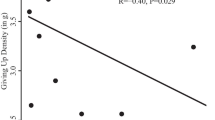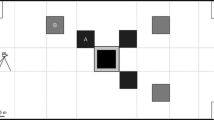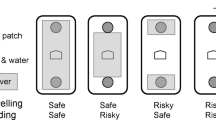Abstract
The giving-up density framework is an elegant and widely adopted mathematical approach to measuring animals’ foraging decisions at non-replenishing artificial resource patches. Under this framework, an animal should “give up” when the benefits of foraging are outweighed by the costs (e.g., predation risk, energetic, and/or missed opportunity costs). However, animals of many species may forage in groups, and group size is expected to alter perceived predation risk and hence influence quitting decisions. Yet, most giving-up density studies assume either that individuals forage alone or that giving-up densities are not affected by group foraging. For animals that forage both alone and in groups, differences in giving-up densities due to group foraging rather than experimental variables may substantially alter interpretation. However, no research to date has directly investigated how group foraging affects the giving-up density. We used remote-sensing cameras to identify instances of group foraging in two species of Rattus across three giving-up density experiments to determine whether group foraging influences giving-up densities. Both Rattus species have been observed to vary between foraging alone and in groups. In all three experiments, solo foragers left higher giving-up densities on average than did group foragers. This result has important implications for studies using giving-up densities to investigate perceived risk, the energetic costs of searching, handling time, digestion, and missed opportunity costs, particularly if groups of animals are more likely to experience certain experimental treatments. It is critically important that future giving-up density studies consider the effects of group foraging.


Similar content being viewed by others
References
Alexander RD (1974) The evolution of social behavior. Annu Rev Ecol Syst 5:325–383
Banks PB, Hughes NK (2012) A review of the evidence for potential impacts of black rats (Rattus rattus) on wildlife and humans in Australia. Wildl Res 39:78–88
Barnard CJ, Sibly RM (1981) Producers and scroungers: a general model and its application to captive flocks of house sparrows. Anim Behav 29:543–550
Barta Z, Liker A, Mónus F (2004) The effects of predation risk on the use of social foraging tactics. Anim Behav 67:301–308
Bedoya-Perez MA, Carthey AJR, Mella VSA, McArthur C, Banks PB (2013) A practical guide to avoid giving up on giving-up densities. Behav Ecol Sociobiol 67:1541–1553
Berger-Tal O, Embar K, Kotler BP, Saltz D (2015) Everybody loses: intraspecific competition induces tragedy of the commons in Allenby’s gerbils. Ecology 96:54–61. doi:10.1890/14-0130.1
Brown JS (1988) Patch use as an indicator of habitat preference, predation risk, and competition. Behav Ecol Sociobiol 22:37–47
Bytheway JP, Carthey AJR, Banks PB (2013) Risk vs. reward: how predators and prey respond to aging olfactory cues. Behav Ecol Sociobiol 67:715–725
Carthey AJR (2013) Naivete, novelty and native status: mismatched ecological interactions in the Australian environment. PhD thesis. The University of Sydney, Sydney
Carthey AJR, Banks PB (2012) When does an alien become a native species? a vulnerable native mammal recognizes and responds to its long-term alien predator. PLoS One 7(2):e31804
Charnov EL (1976) Optimal foraging, the marginal value theorem. Theor Popul Biol 9:129–136
Clark CW, Mangel M (1986) The evolutionary advantages of group foraging. Theor Popul Biol 30:45–75
Coolen I, Giraldeau LA, Vickery W (2007) Scrounging behavior regulates population dynamics. Oikos 116(3):533–539
Dowding JE, Murphy EC (1994) Ecology of ship rats (Rattus rattus) in a kauri (Agathis australis) forest in Northland, New Zealand. NZ J Ecol. 18:19–28
Emerson SE, Brown JS, Whelan CJ, Schmidt KA (2012) Scale-dependent neighborhood effects: shared doom and associational refuge. Oecologia 168(3):659–670
Foley W, McArthur C (1994) The effects and costs of allelochemicals for mammalian herbivores: an ecological perspective. The digestive system in mammals: food form and function. Cambridge University Press, Cambridge, pp 370–391
Giraldeau L-A, Caraco T (2000) Social foraging theory. Princeton University Press, Princeton
Giraldeau L-A, Lefebvre L (1986) Exchangeable producer and scrounger roles in a captive flock of feral pigeons: a case for the skill pool effect. Anim Behav 34:797–803
Hamilton WD (1971) Geometry for the selfish herd. J Theor Biol 31:295–311
Jackson SM (2003) Australian mammals: biology and captive management. CSIRO, Melbourne
Lagory KE (1986) Habitat, group size, and the behaviour of white-tailed deer. Behaviour 98:168–179
Landeau L, Terborgh J (1986) Oddity and the ‘confusion effect’ in predation. Anim Behav 34:1372–1380
MacArthur RH, Pianka ER (1966) On optimal use of a patchy environment. Am Nat 100:603–609
Masini CV, Sauer S, Campeau S (2005) Ferret odor as a processive stress model in rats: neurochernical, behavioral, and endocrine evidence. Behav Neurosci 119:280–292
McArthur C, Orlando P, Banks PB, Brown JS (2012) The foraging tightrope between predation risk and plant toxins: a matter of concentration. Funct Ecol 26:74–83
McEvoy J, Sinn DL, Wapstra E (2008) Know thy enemy: behavioural response of a native mammal (Rattus lutreolus velutinus) to predators of different coexistence histories. Austral Ecol 33:922–931
Molvar EM, Bowyer RT (1994) Costs and benefits of group living in a recently social ungulate: the Alaskan moose. J Mammal 75:621-630
Moody AL, Houston AI, McNamara JM (1996) Ideal free distributions under predation risk. Behav Ecol Sociobiol 38:131–143
Orrock JL, Danielson BJ, Brinkerhoff RJ (2004) Rodent foraging is affected by indirect, but not by direct, cues of predation risk. Behav Ecol 15:433–437
Peakall R, Ebert D, Cunningham R, Lindenmayer D (2006) Mark–recapture by genetic tagging reveals restricted movements by bush rats (Rattus fuscipes) in a fragmented landscape. J Zool 268:207–216
Powell F, Banks PB (2004) Do house mice modify their foraging behaviour in response to predator odours and habitat? Anim Behav 67(4):753–759
Price MV, Correll RA (2001) Depletion of seed patches by Merriam’s kangaroo rats: are GUD assumptions met? Ecol Lett 4:334–343
Pulliam HR (1973) On the advantages of flocking. J Theor Biol 38:419–422
Stephens DW, Krebs JR (1986) Foraging theory. Princeton University Press, Princeton
Stephens DW, Brown JS, Ydenberg R (2007) Foraging: behavior and ecology. University of Chicago Press, Chicago
Watts CHS, Aslin HJ (1981) Rodents of Australia. Angus & Robertson, Sydney
Weerakoon MK, Ruffino L, Cleary GP, Heavener S, Bytheway JP, Smith HM, Banks PB (2014) Can camera traps be used to estimate small mammal population size? In: Fleming P, Meek P, Ballard G, Banks P, Claridge A, Sanderson J, Swann D (eds) Camera trapping: wildlife management and research. CSIRO, Melbourne
Woodside DP (1983) The role of social behaviour and spacing in populations of the bush rat, Rattus fuscipes. PhD thesis. Australian National University, Canberra
Acknowledgments
We would like to acknowledge the help of Malith Weerakoon, Tim Ralph, Brian Ralph, Lynda Ralph, Hayley Griffin, William Carthey, and Roger Carthey in the field. We would also like to acknowledge all of the owners of and carers for animals who donated predator odors to this study. This research was funded by the Hermon Slade Foundation grant HSF 10/10, by a Joyce W. Vickery grant from the Linnean Society of New South Wales, and an Ethel Mary Read grant from the Royal Zoological Society of New South Wales.
Conflict of interest
The authors declare that they have no conflict of interest.
Ethical standard
All animal experiments were conducted in conformity with the guiding principles in the care and use of animals approved by the Council of the American Physiological Society.
Author information
Authors and Affiliations
Corresponding author
Additional information
Communicated by Chris Whelan.
All experiments reported comply with the current laws of the country in which they were performed (Australia).
Rights and permissions
About this article
Cite this article
Carthey, A.J.R., Banks, P.B. Foraging in groups affects giving-up densities: solo foragers quit sooner. Oecologia 178, 707–713 (2015). https://doi.org/10.1007/s00442-015-3274-x
Received:
Accepted:
Published:
Issue Date:
DOI: https://doi.org/10.1007/s00442-015-3274-x




